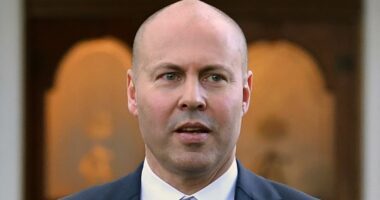Share this @internewscast.com
Toyota has a warning for car buyers: popular products are about to get more expensive.
Mark Templin, the chief operating officer for Toyota in North America, announced that the company plans to implement price increases due to President Donald Trump’s 25 percent tariff on imported vehicles and parts.
‘[Business is] not sustainable longer term without significant price increases,’ he said in a recent event with Ward’s Auto.
‘And the industry already has an affordability problem.’
This statement validates the concerns that consumer advocates have been expressing for months: that car buyers should anticipate experiencing heightened car prices and rising insurance costs.
Toyota anticipates incurring $1.3 billion in tariff expenses during April and May alone, and the company is already predicting a 20 percent decline in profits for the upcoming year.
Templin said the impact won’t stop at the dealership.
Because the tariff targets imported parts as well as vehicles, service costs for existing Toyota owners are likely to rise too.

Toyota has seen a massive sales bump, but predicts a more-than-20 percent profit decline this year
‘Levies on parts will negatively impact the automotive supply chain and will make repairing vehicles more expensive for customers,’ he said.
Toyota’s pricing update comes as the brand dominates the global auto market.
In 2024, the company sold 10.8 million vehicles worldwide, making it the best-selling automaker on the planet.
In the US, the RAV4 SUV became the country’s top-selling passenger vehicle.
Toyota became the most-loved brand in the US this year, according to a study by iseecars.
Still, the mood inside the company is cautious.
About half of Toyota’s US sales come from vehicles assembled outside the country — mostly in Japan, Canada, and Mexico — leaving the brand exposed to a potential price shock.
And Toyota is not alone.

Toyota is already going through a major reboot of its vehicles: the company unveiled its redesigned 2026 RAV4 and is slated to release the C-HR EV

Toyota’s CEO, Koji Sato, has led the company to huge sales heights – the company snatched the crown for world’s best-selling automaker

Toyota is not alone: other carmakers, including Ford and VW, have announced policy and pricing changes to keep up with the 25 percent tariffs
GM’s CEO, Mary Barra, warned that the American manufacturer is expecting to pay between $4 billion and $5 billion in tariffs annually. Ford, which builds 80 percent of its vehicle lineup in the US, predicts it’ll spend $1 billion.
Ford has already announced some price increases on popular models, though the company attributes the increase to design updates rather than tariffs.
Templin said the broader problem is structural.
‘It’s important to understand that supply chains are global,’ he said. ‘They’re complex and they’re very fragile.’
Recent disruptions to that supply chain also lead to Americans spending a lot more on vehicles.
Last year, the average American new vehicle buyer spent more than $48,000 to get a fresh set of wheels.
The average financing for that loan gave most US buyers a monthly bill over $700.
Those pricing shocks were largely attributed to distribution shocks after port, train, and freight workers rebuilt the supply chain after the pandemic.
Meanwhile, drivers were more prone to getting into accidents after the pandemic. Cars, now equipped with increasing safety technology, also became more expensive to repair.
These factors also led car insurance rates to skyrocket.
In 2019, the average American spent less tha $1,500 a year to insure tha median $38,259 vehicle.
This year, standard insurance premiums are closer to $2,100 and vehicle prices remain at $48,424.

















